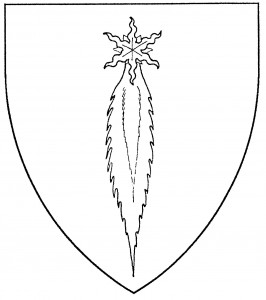A comet is a heavenly body with a long trail of light, manifesting irregularly, and considered a portent of disaster in medieval times. In heraldry, it’s depicted as a mullet or estoile (called the “head”), trailing plumes of vapor or fire (called the “beard”). The head is to chief by default; in Society blazonry, a comet with its head to base is sometimes blazoned a “shooting star” or “falling star”.
There are several styles of comet in heraldic art. The most common form has an estoile as the head, trailing fire, as in the illustration. However, it might be drawn indistinguishably from a mullet of eight points with one point greatly elongated; or as a mullet with a wavy trail. No difference is granted between these styles.
The comet is a period charge, found in the canting arms of de Comma, mid-15th C. [Triv 121]; cf. also the civic arms of Colmar, 1605 [Siebmacher 219], and the illustration in Bossewell, 1572 [II.132]. The known examples of comets in period armory were singly tinctured; having the comet’s head a different tincture than its beard is deemed a step from period practice. For related charges, see estoile, mullet.
Marc of Esfenn bears: Sable, in pale three comets fesswise argent.
Elena Glamorgan bears: Gules, a comet bendwise inverted Or.
Esmirelda Dancingstar bears: Purpure, a shooting star bendwise sinister Or.
